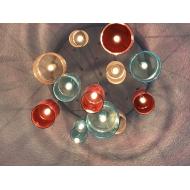To go deeper into the LED area, it is necessary to consider a number of key concepts that have not appeared to date. Besides the electrical characteristics that we analysed in the mentioned entries, in the following article we will consider more parameters such as Correlated Colour Temperature (CCT), Colour Rendering Index (CRI), Luminous flux – Lumen (lm), Luminous intensity – Candela (cd), Luminance – Lux (lm/m2), Luminous efficacy – (lm/w) and Luminous distribution curve.
Correlated Colour Temperature – CCT
The colour temperature can be defined as the sensation perceived by the human eye in the presence of light; it is warm when amber predominates, and cool when blue.
CCT is obtained from comparing the colour within the light spectrum of a light source with the light of a black body, i.e. an “ideal radiator” heated to a particular temperature.
A simple way to understand this is to imagine the range of colours a piece of metal would pass through when heated; it would go from red to blue, by way of amber, yellow and white.
Colour temperature is measured in degrees Kelvin (K):
- Amber: from 1.200K to 2.400K
- Very Warm White: from 2,400K to 2.900K
- Warm White: from 2.900K to 3.900K
- Neutral White or Daylight: from 3.900K to 5.500K
- Cold White: from 5.500K to 7.000K
- Very Cold White: from 7.000K to 9.000K
Colour Rendering Index – CRI
The colour rendering index (CRI – or Ra) measures the ability of a light source to reproduce the colours of an object faithfully in comparison with an ideal or natural light source.
It is measured as indicated by the International Commission on Illumination (CIE) 13.3 – Method of measuring and specifying colour rendering properties of light sources. This method is applied on a scale of 0 to 100:
1. 90 < Ra ≤ 100: Very efficient. Special indoor applications.
2. 80 ≤ Ra ≤ 90: Efficient. Used indoors
3. 70 ≤ Ra ≤ 80: Normal. Used indoors and outdoors
4. Ra < 70: Deficient. Unusual for this technology
Luminous flux – Lumen (lm)
The luminous flux is the power emitted in a form of light radiation to which the human eye is sensitive.
It is measured as the amount of light emitted by a light source in all directions. Its symbol and SI unit of measurement is the lumen (lm).
Luminous intensity – Candela (cd)
Luminous flux is defined on the basis of the basic SI unit, the candela (cd).
The candela, also referred to as luminous intensity, is the part of the flux emitted by a light source in a particular direction given by the solid angle that contains it.
Illuminance – Lux (lm/m2)
Luminous flux should not be confused with another magnitude: illuminance. The unit by which the latter is measured is the lux (lm/m2), which represents the amount of luminous flux per unit area, i.e. the density of the light on a given surface.
Luminous efficacy – (lm/w)
Luminous efficacy or performance is the ratio of the amount of light emitted (lm) to the power consumed (W). It is measured, therefore, in lm/W.
Luminous distribution curve
The luminous distribution curve is obtained by taking light intensity measurements at different angles around a light source. It is normally represented by polar coordinates.
The distance from any point on the curve to the centre indicates the light intensity of the source in that direction.
Generally speaking these curves indicate the maximum light intensity value in candelas for every 1,000lm.
Marta Forcén, engineer I+D+i








